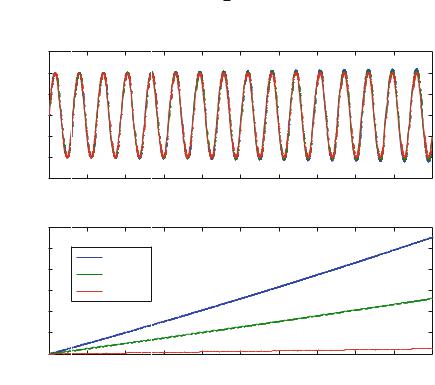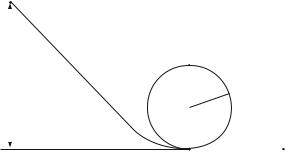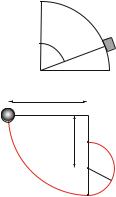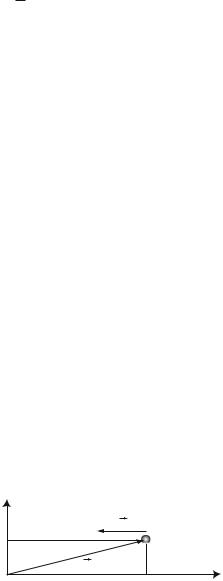
- •Preface
- •Contents
- •1 Introduction
- •1.1 Physics
- •1.2 Mechanics
- •1.3 Integrating Numerical Methods
- •1.4 Problems and Exercises
- •1.5 How to Learn Physics
- •1.5.1 Advice for How to Succeed
- •1.6 How to Use This Book
- •2 Getting Started with Programming
- •2.1 A Python Calculator
- •2.2 Scripts and Functions
- •2.3 Plotting Data-Sets
- •2.4 Plotting a Function
- •2.5 Random Numbers
- •2.6 Conditions
- •2.7 Reading Real Data
- •2.7.1 Example: Plot of Function and Derivative
- •3 Units and Measurement
- •3.1 Standardized Units
- •3.2 Changing Units
- •3.4 Numerical Representation
- •4 Motion in One Dimension
- •4.1 Description of Motion
- •4.1.1 Example: Motion of a Falling Tennis Ball
- •4.2 Calculation of Motion
- •4.2.1 Example: Modeling the Motion of a Falling Tennis Ball
- •5 Forces in One Dimension
- •5.1 What Is a Force?
- •5.2 Identifying Forces
- •5.3.1 Example: Acceleration and Forces on a Lunar Lander
- •5.4 Force Models
- •5.5 Force Model: Gravitational Force
- •5.6 Force Model: Viscous Force
- •5.6.1 Example: Falling Raindrops
- •5.7 Force Model: Spring Force
- •5.7.1 Example: Motion of a Hanging Block
- •5.9.1 Example: Weight in an Elevator
- •6 Motion in Two and Three Dimensions
- •6.1 Vectors
- •6.2 Description of Motion
- •6.2.1 Example: Mars Express
- •6.3 Calculation of Motion
- •6.3.1 Example: Feather in the Wind
- •6.4 Frames of Reference
- •6.4.1 Example: Motion of a Boat on a Flowing River
- •7 Forces in Two and Three Dimensions
- •7.1 Identifying Forces
- •7.3.1 Example: Motion of a Ball with Gravity
- •7.4.1 Example: Path Through a Tornado
- •7.5.1 Example: Motion of a Bouncing Ball with Air Resistance
- •7.6.1 Example: Comet Trajectory
- •8 Constrained Motion
- •8.1 Linear Motion
- •8.2 Curved Motion
- •8.2.1 Example: Acceleration of a Matchbox Car
- •8.2.2 Example: Acceleration of a Rotating Rod
- •8.2.3 Example: Normal Acceleration in Circular Motion
- •9 Forces and Constrained Motion
- •9.1 Linear Constraints
- •9.1.1 Example: A Bead in the Wind
- •9.2.1 Example: Static Friction Forces
- •9.2.2 Example: Dynamic Friction of a Block Sliding up a Hill
- •9.2.3 Example: Oscillations During an Earthquake
- •9.3 Circular Motion
- •9.3.1 Example: A Car Driving Through a Curve
- •9.3.2 Example: Pendulum with Air Resistance
- •10 Work
- •10.1 Integration Methods
- •10.2 Work-Energy Theorem
- •10.3 Work Done by One-Dimensional Force Models
- •10.3.1 Example: Jumping from the Roof
- •10.3.2 Example: Stopping in a Cushion
- •10.4.1 Example: Work of Gravity
- •10.4.2 Example: Roller-Coaster Motion
- •10.4.3 Example: Work on a Block Sliding Down a Plane
- •10.5 Power
- •10.5.1 Example: Power Exerted When Climbing the Stairs
- •10.5.2 Example: Power of Small Bacterium
- •11 Energy
- •11.1 Motivating Examples
- •11.2 Potential Energy in One Dimension
- •11.2.1 Example: Falling Faster
- •11.2.2 Example: Roller-Coaster Motion
- •11.2.3 Example: Pendulum
- •11.2.4 Example: Spring Cannon
- •11.3 Energy Diagrams
- •11.3.1 Example: Energy Diagram for the Vertical Bow-Shot
- •11.3.2 Example: Atomic Motion Along a Surface
- •11.4 The Energy Principle
- •11.4.1 Example: Lift and Release
- •11.4.2 Example: Sliding Block
- •11.5 Potential Energy in Three Dimensions
- •11.5.1 Example: Constant Gravity in Three Dimensions
- •11.5.2 Example: Gravity in Three Dimensions
- •11.5.3 Example: Non-conservative Force Field
- •11.6 Energy Conservation as a Test of Numerical Solutions
- •12 Momentum, Impulse, and Collisions
- •12.2 Translational Momentum
- •12.3 Impulse and Change in Momentum
- •12.3.1 Example: Ball Colliding with Wall
- •12.3.2 Example: Hitting a Tennis Ball
- •12.4 Isolated Systems and Conservation of Momentum
- •12.5 Collisions
- •12.5.1 Example: Ballistic Pendulum
- •12.5.2 Example: Super-Ball
- •12.6 Modeling and Visualization of Collisions
- •12.7 Rocket Equation
- •12.7.1 Example: Adding Mass to a Railway Car
- •12.7.2 Example: Rocket with Diminishing Mass
- •13 Multiparticle Systems
- •13.1 Motion of a Multiparticle System
- •13.2 The Center of Mass
- •13.2.1 Example: Points on a Line
- •13.2.2 Example: Center of Mass of Object with Hole
- •13.2.3 Example: Center of Mass by Integration
- •13.2.4 Example: Center of Mass from Image Analysis
- •13.3.1 Example: Ballistic Motion with an Explosion
- •13.4 Motion in the Center of Mass System
- •13.5 Energy Partitioning
- •13.5.1 Example: Bouncing Dumbbell
- •13.6 Energy Principle for Multi-particle Systems
- •14 Rotational Motion
- •14.2 Angular Velocity
- •14.3 Angular Acceleration
- •14.3.1 Example: Oscillating Antenna
- •14.4 Comparing Linear and Rotational Motion
- •14.5 Solving for the Rotational Motion
- •14.5.1 Example: Revolutions of an Accelerating Disc
- •14.5.2 Example: Angular Velocities of Two Objects in Contact
- •14.6 Rotational Motion in Three Dimensions
- •14.6.1 Example: Velocity and Acceleration of a Conical Pendulum
- •15 Rotation of Rigid Bodies
- •15.1 Rigid Bodies
- •15.2 Kinetic Energy of a Rotating Rigid Body
- •15.3 Calculating the Moment of Inertia
- •15.3.1 Example: Moment of Inertia of Two-Particle System
- •15.3.2 Example: Moment of Inertia of a Plate
- •15.4 Conservation of Energy for Rigid Bodies
- •15.4.1 Example: Rotating Rod
- •15.5 Relating Rotational and Translational Motion
- •15.5.1 Example: Weight and Spinning Wheel
- •15.5.2 Example: Rolling Down a Hill
- •16 Dynamics of Rigid Bodies
- •16.2.1 Example: Torque and Vector Decomposition
- •16.2.2 Example: Pulling at a Wheel
- •16.2.3 Example: Blowing at a Pendulum
- •16.3 Rotational Motion Around a Moving Center of Mass
- •16.3.1 Example: Kicking a Ball
- •16.3.2 Example: Rolling down an Inclined Plane
- •16.3.3 Example: Bouncing Rod
- •16.4 Collisions and Conservation Laws
- •16.4.1 Example: Block on a Frictionless Table
- •16.4.2 Example: Changing Your Angular Velocity
- •16.4.3 Example: Conservation of Rotational Momentum
- •16.4.4 Example: Ballistic Pendulum
- •16.4.5 Example: Rotating Rod
- •16.5 General Rotational Motion
- •Index

11.5 Potential Energy in Three Dimensions |
341 |
× F = |
∂ yz |
− ∂ zy i + |
∂ zx |
||||||||
|
|
∂ F |
|
∂ F |
|
|
|
∂ F |
|||
|
|
|
|
|
|
|
|
|
|
|
|
= |
∂ x − |
|
∂ y |
= |
|
|
|||||
|
|
∂ x |
|
∂ − y |
k |
|
|
2k . |
|||
|
|
|
|
|
|
|
|||||
The force is therefore not conservative.
− ∂ xz j + |
∂ xy |
− ∂ yx k |
|
∂ F |
∂ F |
|
∂ F |
|
|
(11.138) |
|
11.6 Energy Conservation as a Test of Numerical Solutions
When we are solving the equations of motion based on Newton’s second law, we can use our general knowledge of physics to check the results. This is what we do when we first look at the result of a calculation: If it is obviously wrong, we dismiss it immediately. For example, if you study a falling raindrop with air resistance, you know something is wrong if you calculation tells you the drop is accelerating upwards. Our physical intuition is therefore important both for the interpretation of the results, but also for evaluating their correctness. However, we can leverage our knowledge of physics further. For example, we can use conservation laws to test the accuracy of our solutions and of our solution methods. This is common practice for working physicists, and should be a part of your regular professional routine: Always check for energy (and later momentuum) conservation!
Spring-block system: Let us demonstrate this through a simple example: A springblock system with a block (m = 0.1 kg) attached to a spring (k = 1000 N/m). We assume that the block is moving along the x -axis and that it is in equilibrium when x = 0. If the force from the spring is the only force acting on the block Newton’s second law gives:
Fx = −k x = ma a = −k x . |
(11.139) |
Let us calculate the motion starting from x (t0) = 0 m with a velocity v(t0) = v0.
Euler-method solution: In this case we know the exact solution of this equation. However, let us now rather analyze our numerical solution methods. We start by using Euler’s method. We find the velocity and position at time ti +1 = ti + t from the velocity and position at time ti using:
v(ti + |
t ) = v(ti ) + a(ti ) |
t |
(11.140) |
x (ti + |
t ) = x (ti ) + v(ti ) |
t |
This method is implemented in the following program:
from |
pylab import * |
||
m = 0.1 |
# kg |
||
k = 1000 |
# N/m |
||
x0 |
= |
0.0 |
# m |
v0 |
= |
1.0 |
# m/s |
time |
= 1.0 |
# s |
|

342 |
11 Energy |
n = 100000 |
|
dt = time/n |
|
t = zeros(n,float) |
|
x = zeros(n,float) |
|
v = zeros(n,float) |
|
x[0] = x0 |
|
t[0] = 0.0 |
|
v[0] = v0 |
|
for i in range(n-1): |
|
F = -k*x[i] |
|
a = F/m |
|
v[i+1] = v[i] + dt*a |
|
x[i+1] = x[i] + dt*v[i] |
|
t[i+1] = t[i] + dt |
|
plot(t,x); xlabel(’t (s)’), ylabel(’x (m)’) |
|
Validation: The resulting motion is shown in Fig. 11.17. However, if we did not know the exact solution for the motion, it would be difficult to evaluate if this solution is correct. Let us therefore check the solution by calculating the total energy of the block. Because the block is affected by only one force, which depends on the position of the block alone, the total energy of the block is conserved. In this case we know the potential energy of the block:
|
0.015 |
|
|
0.01 |
|
[m] |
0.005 |
|
0 |
||
x |
||
|
||
|
−0.005 |
|
|
−0.01 |
|
|
−0.015 |
|
|
0 |
|
|
0.062 |
|
|
0.06 |
|
[J] |
0.058 |
|
0.056 |
||
E |
||
|
||
|
0.054 |
|
|
0.052 |
|
|
0.05 |
|
|
0 |
|
1 |
|
U (x ) = |
2 k x 2 . |
(11.141) |
0.1 |
0.2 |
0.3 |
0.4 |
0.5 |
0.6 |
0.7 |
0.8 |
0.9 |
1 |
t [s]
t = 10 − 4
t = 10 − 5
t = 10 − 6
0.1 |
0.2 |
0.3 |
0.4 |
0.5 |
0.6 |
0.7 |
0.8 |
0.9 |
1 |
t [s]
Fig. 11.17 Plot of the motion, x (t ), and the energy, E (t ), for a block in a spring calculated using Euler’s method
11.6 Energy Conservation as a Test of Numerical Solutions |
|
|
343 |
|||
The total energy is therefore: |
|
|
|
|
|
|
E = U (x ) + K = |
1 |
k x 2 + |
1 |
mv2 . |
(11.142) |
|
|
|
|
||||
2 |
2 |
|||||
This quantity should be conserved. We calculate and plot the energy in the program by adding the following lines:
U = 0.5*k*x**2 K = 0.5*m*v**2 E = U + K
plot(t,E), xlabel(’t (s)’), ylabel(’E (J)’)
The result in Fig. 11.17 shows that the energy is not conserved. Something may be wrong. We know that we always make errors in our numerical integration due to numerical rounding. Could this be a result of numerical round-off errors? In addition, we know that the numerical scheme is not exact itself. It is only valid in the limit when t goes to zero and in this limit the effect of round-off error will be important.
Discussion: First, we notice that the errors are rather large. We would expect roundoff errors to be related to the smallest numbers represented on the machine, and not on the order of 1 % of the value of the energy. However, it is often easier to check if the error is related to the numerical algorithm—we simply reduce the value of t and see what happens. Figure 11.17 shows that when t is reduced, the error is also reduced. We therefore conclude that the main contribution to the error we are observing comes from the numerical method. Our numerical scheme is not conserving energy for this equation. This is, unfortunately, a well-known problem with Euler’s method: The error in the numerical solution to even a simple problem like a block in a spring increases with time.
Euler-Cromer method solution: We can fix this by introducing a higher-order method such as Euler-Cromer’s method. This is done by a simple modification of the numerical scheme:
v(ti + |
t ) = v(ti ) + a(ti ) t |
(11.143) |
x (ti + |
t ) = x (ti ) + v(ti + t ) t |
This method is implemented by exchanging a single line in the program:
x[i+1] = x[i] + dt*v[i]
with
x[i+1] = x[i] + dt*v[i+1]
and the resulting plot of E (t ) is shown in Fig. 11.18. Now, the energy does not diverge, but instead oscillates around the theoretical, constant value. The amplitude of the oscillations decrease with t . This indicates that the solution method we have used now is sound.

344
E [J]
6
4
2
0
−2
−4
−6
11 Energy
x 10−5
t = 10 − 4 t = 10 − 5 t = 10 − 6
0 |
0.1 |
0.2 |
0.3 |
0.4 |
0.5 |
0.6 |
0.7 |
0.8 |
0.9 |
1 |
t [s]
Fig. 11.18 Plot of the energy, E (t ), for a block in a spring calculated using Euler-Cromer’s method
Summary
Conservative forces: A force F is conservative if the work done by the force only depends on the end-points of the motion. That is, if the work is independent of the path.
Potential energy: For a conservative force F we can write the work from r0 to r1 as a function of the end points:
1
W = F · d r = U (r0) − U (r1)
0
The quantity U (r) is called the potential energy and is a positional energy.
Potential energy function in one dimension: For a one-dimensional force, the force is conservative if and only if it only depends on the position. The force can be written as the derivative of the potential energy U (x ):
dU
F = −
d x
Potential energy function in three dimension: For a three-dimensional force, the force is conservative if and only if the force can be written as the gradient of a field
U :
F = − U ,
That is F must depend on the position r only, and × F = 0 as well.
Kinetic energy: The kinetic energy of an object is defined as:
K = 1 mv2 .
2
11.6 Energy Conservation as a Test of Numerical Solutions |
345 |
Mechanical energy: The mechanical energy of a system is the sum of the kinetic and the potential energy:
E = K + U
Conservation of mechanical energy: If an object is only subject to conservative forces, the mechanical energy is conserved throughout the motion:
K (r0) + U (r0) = K (r1) + U (r1)
Energy diagrams: An energy diagram illustrates the potential and kinetic energy for an object as a function of position based on a plot of the potential energy U (x ). The potential energy can be interpreted as an energy landscape for the motion. A motion with constant mechanical energy, E = U + K , is illustrated by a horizontal line in this plot.
Equilibrium points: An equilibrium point occurs where the force is zero. This corresponds to a local extremum of the potential energy. An equilibrium point is stable in a local minimum and unstable in a local maximum.
Kinetic energy in energy diagrams: The kinetic energy can be found from the plot as the distance from the potential energy up to the line giving the total energy, E . An object cannot have negative kinetic energy and therefore cannot enter a region where the total energy is less than the potential energy.
The energy principle: The energy principle states that
E = WN C .
A change in (mechanical) energy of an object is equal to the work done by nonconservative forces, WN C .
Non-conservative forces: The energy principle can be used in reverse: The work done by non-conservative forces is equal to the change in mechanical energy:
t1
WN C = FN C · vd t = (K (r1) + U (r1)) − (K (r0) + U (r0)) .
t0
Exercises
Discussion Questions
11.1 Potential energy. An object is subject to a force that is zero everywhere, exept between x = 1 m and x = 2 m. Is the force conservative? Can you find the corresponding potential energy?

346 |
11 Energy |
11.2Potential energy of electic field. The force on an electron from an electric field is Fx = −F0 sin ωt sin k x . Is the force conservative? Can you find the potential energy for this force?
11.3Zero level for potential energy. Can you choose the zero level for the potential energy of a spring force, so that the potential energy is zero when the spring is
extended a distance x ?
11.4Losing energy. You drop a book onto a table, where it comes to rest. Is the mechanical energy conserved in this process?
11.5Energy diagram for a bouncing ball. Draw an energy diagram for a ball bouncing on the floor. You can assume all forces are conservative.
11.6Potential energy of bow-shot. You fire an arrow vertically using a bow. When is the total potential energy of the arrow at its maximum?
11.7Potential energy from Earth and Moon. You fly from the Earth to the Moon. Sketch your total potential energy as a function of position. Include only interactions with the Earth and the Moon.
Problems
11.8 The loop. A block is sliding along the track illustrated in Fig. 11.19. First, the block slides down the ramp, then around the loop, and onto a rough, flat table. The block starts from rest at point A at a height h above the ground. The track is frictionless from A to B and around the loop. But from B to D the dynamic coefficient of friction between the block and the track is µ.
(a) Find the speed vB of the block when at point B before going around the loop. (b) Find the speed vC of the block at the point C.
Fig. 11.19 Illustration of a |
|
A |
|
|
|
|
track |
|
C |
|
|
|
|
|
|
|
|
|||
|
|
|
|
|
||
|
h |
|
|
|
||
|
|
|
|
R |
|
|
|
|
|
|
|
|
|
|
|
B |
µ |
D |
||
|
|
|||||
|
|
|
|
|
|
|

11.6 Energy Conservation as a Test of Numerical Solutions |
347 |
Fig. 11.20 A block sliding on a cylinder surface
Fig. 11.21 A two-point pendulum
θ
R
L
 O
O
h B
P r
A
(c) What is the condition on the speed vC for the block to keep in contact with the track? Explain what happens if this condition is not fulfilled.
(d) How high, h, above the ground must the block start to make it around the loop? (e) After the block is leaving the loop at point B, it slides onto the rough table. How far does the block slide before stopping?
11.9Sliding on a cylinder. A block is sliding on the outside surface of a frictionless cylinder, as illustrated in Fig. 11.20. The block starts on the top of the cylinder with zero velocity (or a very small velocity, so that it just starts to move). The mass of the block is m and the radius of the cylinder is R.
(a) If the block is in contact with the surface, find the speed of the block as a function of the angle θ .
(b) For what value of θ does the block lose contact with the cylinder?
(c) Can you explain how your answers would change if there was a friction force between the block and the surface?
11.10Vertical pendulum. A pendulum consists of a sphere of mass m attached to a massless rope of length L . You start with the rope in your hand and the sphere hanging down. You hit the sphere, giving it a horizontal velocity v0.
(a) What is the speed of the sphere at the top of the path?
(b) How large must v0 be for the sphere to be able to make a complete revolution with the rope tight at all times?
11.11Two-point pendulum. A pendulum consists of a sphere of mass m attached to a massless rope of length L . You release the sphere a horizontal position, as illustrated in Fig. 11.21. The rope hits a stick (P) at a distance h below the attachment point, O, of the pendulum, and continues rotating around the point P. The length of the pendulum is therefore reduced.
(a) What is the speed of the sphere at the point A at the bottom of the path?
(b) What is the speed of the sphere when it is at point B directly above the stick? (c) How large must h at least be for the sphere to reach this point with a tight rope?
348 11 Energy
11.12 Lennard-Jones Potential. The Lennard-Jones potential is often used to describe the interaction between two atoms in a diatomic molecule. The potential energy
of the molecule is: |
r |
− r |
|
, |
(11.144) |
||
U (r ) = U0 |
|||||||
|
|
a 12 |
|
b |
6 |
|
|
|
|
|
|
|
|
||
where r is the distance between the atoms.
(a) What is the force acting on one of the atoms from the other atom? (b) Sketch the potential U (r ).
(c) Find and classify the equilibrium points.
11.13A bouncing ball—part 1. You lift a ball of radius R and mass m vertically up, until its center is a height h above the ground, and let it go. The ball starts from rest. You may model the collision between the ball and the ground using a spring force, where all the deformation occurs in the ball. The spring constant is k.
(a) What is the height above ground of the center of the ball as the ball comes in contact with the ground?
(b) What is the speed of the ball when it comes in contact with the ground?
(c) What is the maximum deformation, δy, of the ball during the collision with the ground?
11.14A bouncing ball—part 2. You lift a ball of radius R and mass m vertically up, until its center is a height h above the ground. Here, you hit the ball, giving it an initial horizontal velocity v0. You may model the collision between the ball and the ground using a spring force acting in the direction normal to the ground. You can assume that all the deformation occurs in the ball and that the spring constant is k. There is no friction between the ball and the ground.
(a) What is the (vector) velocity of the ball when it comes in contact with the ground? (b) What is the (vector) velocity of the ball when it reaches its maximum compression?
(c) What is the maximum deformation, δy, of the ball during the collision with the ground?
(d) What is the (vector) velocity of the ball as it loses contact with the ground?
(e) Based on your results, can you propose a law for how the velocity of a ball changes during a collision with a (frictionless) wall?
Projects
11.15 Shooting Ions. In this project you will apply you knowledge of potential energy to find the force law for the collision between an ion and a molecule, and apply this to address the motion of the ions through the collision, integrating the equations of motion in two dimensions.

11.6 Energy Conservation as a Test of Numerical Solutions |
349 |
We will study the motion of a small ion with mass m that is shot toward a massive molecule located in the origin. The molecule is so large that you can assume that it does not move throughout the whole process. We start by a simplified case, and address a one-dimensional motion along the x -axis. The interaction between the ion and the molecule is described by the potential:
C |
(11.145) |
U (x ) = , |
x
where C is a know constant, and x is the position of the ion. The ion starts at the position x = b with the velocity v0, where b > 0 and v0 < 0. You can ignore all other forces acting on the ion.
(a) Sketch the potential, find equilibrium points and characterize these. Show the motion of the ion in the energy diagram, and describe the motion of the ion.
(b) How close to the origin does the ion get?
(c) What is the velocity of the ion when it is infinitely far away from the origin? Let us now address the same process, but in two dimensions. We assume that the
ion starts in the position r0 = (b, d ), where b and d are two given lengths. You may assume that d is less than b, as illustrated in Fig. 11.22. The ion starts with the velocity v0 = (v0, 0), where v0 < 0. The potential energy for the ion due to the interaction with the molecule is now:
|
C |
|
|||
U (r) = |
|
|
, |
(11.146) |
|
|
|
||||
|
|
r |
|
||
where r = |r|. You can neglect all other interactions. |
|
||||
(d) Show that the force on the ion is: |
|
||||
F(r) = |
C |
|
|||
|
r . |
(11.147) |
|||
r 3 |
|||||
(e) Find an expression for the acceleration of the ion. What are the initial conditions for the motion?
(f ) Write a program to find the motion of the ion, that is, to find the velocity and position of the ion as a function of time.
(g) Write a program to find the motion of the ion, that is, to find the velocity and position of the ion as a function of time for m = 1, b = 1, d = 0.2, C = 1, and v0 = 2.5.
Fig. 11.22 Initial condition |
y |
for two-dimensional case |
|
v0
d
r0
O |
b |
x |
|
350 |
11 Energy |
(h) Use your script to study the behavior of the ion as you vary v0 from 0.5 to 10.0. Provide a simple description of what is happening.
(i) Is possible to choose a value for v0 to make the ion move radially outward after the collision? (The ion moves radially outward if the velocity is parallel with the position-vector r).
